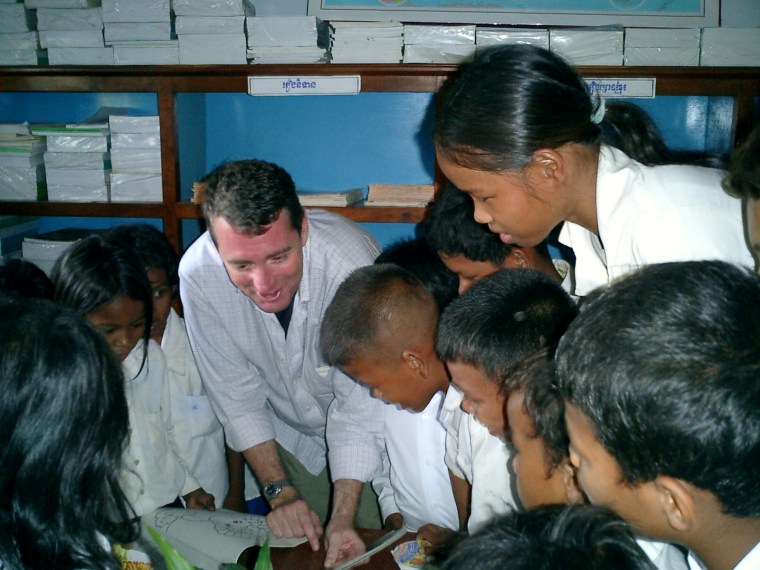On a rare vacation in Nepal in 1998, a chance encounter between Microsoft executive John Wood and a Nepalese teacher changed the businessman’s life.
The teacher introduced Wood to a world where books are a hot commodity, taking him to a school where books were considered so valuablethat the teachers wouldn’t even allow the students to touch them without the protection of plastic sheets. The revelation led Wood to make a promise to the children: One day he would return with books.
“When I made a decent amount of money at Microsoft at a young age I felt with the Microsoft stock I just got lucky,” Wood said. “You know, you work hard but who’s to say that you deserve all that money? I was just trying to figure something out I could do with it – to not turn into somebody who wanted to retire at a young age and withdraw from society and instead find a way to engage.”
Wood, who said his parents were instrumental in stirring his philanthropic passion, returned to Nepal with his father just under a year later with more than 3,000 books. Donkeys hauled them up a mountain and delivered them to schools throughout the area.
During previous travels, Wood had seen the abject poverty and remembers thinking, “Somebody should do something.” But while delivering the books, he remembers concluding that “maybe I should do something and maybe I should stop making excuses and get started right away.”
Carnegie provided role model
With Andrew Carnegie, a leader in the creation and expansion of public libraries in America, as his role model, Wood left Microsoft in 1999 to embark on a new career as a philanthropist. Nine years later, he is the CEO of Room to Read, the nonprofit he founded to provide children with books and libraries and pursue other educational initiatives to underprivileged nations. He’s also an author, having penned a biography in 2006 titled, “Leaving Microsoft to Change the World: An Entrepreneur’s Odyssey to Educate the World’s Children.”
Under his guidance, Room to Read has developed five programs focused on expanding or building schools and libraries, providing girls with scholarships, teaching languages and publishing in local languages. The organization works closely with local communities to determine the greatest needs and meet them.
The libraries are the centerpiece of Room to Read’s program. Each library has between 300 and 1,000 books in the local language and in English. And the organization gets the most out of its resources: Each $150 donation enables it to print 150 local language children books; $4,000 opens a reading room; and $14,000 can build an entire library.
The Room to Grow scholarship program also enables the organization to educate a girl who would otherwise miss out on school for just $250 a year.
‘Leading with the solution’
Room to Read focuses on the solutions because Wood feels that “people really love to hear solutions and know where their money is going. It’s all about leading with the solution and hoping that people will choose to invest in it.”
The organization currently is working in six Asian countries (Cambodia, India, Laos, Nepal, Sri Lanka and Vietnam) and two African countries (South Africa, Zambia).
After reaching the remarkable rate of opening 1,600 libraries a year (or more than four a day), the nonprofit last year marked an amazing milestone — its 5,000th library.
Room to Read, working with Cathay Pacific Airways, Boeing and Scholastic Books, celebrated the achievement on Nov. 29 with a symbolic flight on an extended range jet dubbed Literacy One, which carried a portion of the 400,000 books donated by Scholastic.

After landing in Hong Kong, workers unpacked the precious cargo and distributed the books to Room to Read libraries throughout Asia. Many went to Cambodia, where many libraries were destroyed by the Khmer Rouge.
Room to Read says it also has built more than 440 schools, published 226 new local language children's titles, donated 3 million books, established 150 computer and language labs and funded 4,036 long-terms girls' scholarships. To date, the organization estimates that these projects have impacted the lives of more than 1.7 million children.
Room to Read was recently honored by former President Bill Clinton at the Clinton Global Initiative conference. It was there that Wood announced Room to Read’s plans to drastically expand the organization’s reach.
“While we’re excited that we’ve open 5,000 libraries in eight years we feel that we can do it a lot better and a lot faster if we have the capital,” he said. “We’ve announced a commitment … to go from 5,000 libraries to 10,000 libraries by 2010.” That would mean more than 3 million children would have access to Room to Read libraries, he estimated.
Devoted to efficiency
Room to Read prides itself on efficiency, and Wood says the organization is able to keep its overhead costs low – between 12 and 13 percent of its revenue. The CEO makes sure he does all he can to keep expenses low, often staying with friends when traveling or flying on donated frequent flyer miles, “when we’re not borrowing a Boeing 777 300-ER from Cathay Pacific,” he jokes.
Despite his organization’s success, Wood says he is motivated to do more. “It feels as urgent as ever for me because I feel like we’re in this battle against the clock,” said Wood, who lives in San Francisco when he is not traveling on behalf of Room to Read. “Every day we don’t reach these kids is a day we don’t give back.”
Room to Read anticipates that 90 percent of this year’s activity will occur in the countries where it already has an established presence. But it also is planning to expand to Bangladesh and Zambia, all while keeping an eye on the goal of 10,000 libraries by 2010.
Referring to the 1.5 million kids the organization has reached so far, Wood said, “It’s been a great year… but we’re fully focused on 2008, 2009 and 2010 and asking, ‘How do we double our reach?’”
